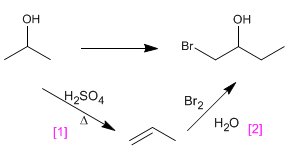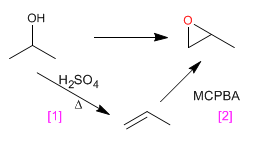Schlagen Sie eine geeignete Reaktionsfolge vor, um jede der folgenden Verbindungen aus dem angegebenen Ausgangsmaterial herzustellen. Sie können jedes organische oder anorganische Reagenz verwenden, das Sie für notwendig halten.
a) 1-Brombutan aus 2-Brombutan
b) 1,2-Dibrompropan aus 2-Brompropan
c) 1-Brom-2-propanol aus 2-Propanol
d) 1,2-Epoxypropan aus 2-Propanol
e) Cyclopentyliodid aus Cyclopentan
f) trans-1,2-Dichlorcyclopentan aus Cyclopentan.
LÖSUNG:
a) 1-Brombutan aus 2-Brombutan

b) 1,2-Dibrompropan aus 2-Brompropan

[1] Eliminierung mit starker Base zur Bildung des Alkens.
[2] Antihalogenierung des Alkens mit Br 2 /CCl 4
c) 1-Brom-2-propanol aus 2-Propanol

[1] Dehydratisierung von Alkohol zur Bildung des Alkens.
[2 ] Bildung von Bromhydrin durch Reaktion von Alken mit Br 2 /H2O
d) 1,2-Epoxypropan aus 2-Propanol

[1] Dehydratisierung von Alkohol zur Bildung des Alkens.
[2] Epoxidierung von Alken mit MCPBA
e) Cyclopentyliodid aus Cyclopentan

[1] Radikalische Halogenierung des Alkans. Mit I 2 /light geht das nicht.
[2] Bimolekulare nukleophile Substitution. Eine Eliminierung gefolgt von einer Addition von HI an das Alken kann ebenfalls durchgeführt werden.
f) trans -1,2-Dichlorcyclopentan aus Cyclopentan.








